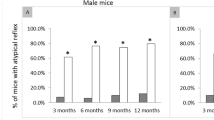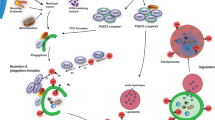Abstract
The mottled mouse has been proposed as an animal model for Menkes disease, an X–linked disorder of copper transport. The recent isolation of a copper–transporting ATPase gene responsible for Menkes disease has allowed us to test this hypothesis. Here we report the isolation and sequence of the mouse homologue of this gene. We show that two mottled (Mo) alleles, dappled (Modp) and blotchy (Mobio), have abnormalities in the murine mRNA and that Modp has a partial gene deletion. These studies prove that the mottled mouse is the murine model for Menkes disease, providing the basis for future biochemical and therapeutic studies.
This is a preview of subscription content, access via your institution
Access options
Subscribe to this journal
Receive 12 print issues and online access
$209.00 per year
only $17.42 per issue
Buy this article
- Purchase on Springer Link
- Instant access to full article PDF
Prices may be subject to local taxes which are calculated during checkout
Similar content being viewed by others
References
Fraser, A.S., Sobey, S. & Spicer, C.C. Mottled, a sex-modified lethal in the house mouse. J. Genet. 51, 217–221 (1953).
Lyon, M.F. Action in the X-chromosome of the Mouse (Mus musculus L). Nature 190, 372–373 (1961).
Miller, J. in X-linked traits: A Catalogue of Loci in Nonhuman Mammals 115–125 (Cambridge University Press, Cambridge, 1990).
Hunt, D.M. Primary defect in copper transport underlies mottled mutants in the mouse. Nature 249, 852–654 (1974).
Darwish, H.M., Hoke, J.E. & Ettinger, M.J. Kinetics of Cu(II) transport and accumulation by hepatocytes from copper-deficient mice and the brindled mouse model of Menkes disease. J. biol. Chem. 258, 13621–13626 (1983).
Packman, S. Regulation of copper metabolism in the mottled mouse. Arch. Dermatol. 123, 1545–1547 (1987).
Sayed, A.K., Edwards, J.A. & Bannerman, R.M. Copper metabolism of cultured fibroblasts from the brindled mouse (gene symbol Mobr). Proc. Soc. Exp. Biol. Med. 186, 153–156 (1981).
Phillips, M., Camakaris, J. & Danks, D.M. A comparison of phehotype and copper distribution in biotchy and brindled mutant mice and in nutritionally copper deficient controls. Biol. Trace Elem. Res. 29, 11–29 (1991).
Hunt, D.M. Catecholamine biosynthesis and the activity of a number of copper-dependent enzymes in the copper deficient mottled mouse mutants. Comp. Biochem. Physiol. 57, 79–83 (1977).
Hunt, D.M. & Johnson, D.R. An inherited deficiency in noradrenaline biosynthesis in the brindled mouse. J. Neurochem. 19, 2811–9 (1972).
Rezek, D.L. & Moore, C.L. Depletion of brain mitochondria cytochrome oxidase in the mottled mouse mutant. Exp. Neurol. 91, 640–645 (1986).
Rowe, D.W., McGoodwin, E.B., Martin, G.R. & Grahn, D. Decreased lysyl oxidase activity in the aneurysm-prone, mottled mouse. J. biol. Chem. 252, 939–942 (1977).
Starcher, B.C., Madaras, J.A. & Tepper, A.S. Lysyl oxidase deficiency in lung and fibroblasts from mice with hereditary emphysema. Biochem. Biophys. Res. Common. 78, 706–712 (1977).
Danks, D.M. in The Metabolic Basis of Inherited Disease (eds Scrives, C. et al.) 1411–1432 (McGraw-Hill, New York, 1989).
Herd, S.M., Camakaris, J., Christofferson, R., Wookey, P. & Danks, D.M. Uptake and efflux of copper-64 in Menkes'-disease and normal continuous lymphoid cell lines. Biochem. J. 247, 341–347 (1987).
Horn, N. Copper incorporation studies on cultured cells for prenatal diagnosis of Menkes' disease. Lancet 1, 1156–1158 (1976).
Brockdorff, N. et al. High-density molecular map of the central span of the mouse X chromosome. Genomics 10, 17–22 (1991).
Tonnesen, T., Petterson, A., Kruse, T.A., Gerdes, A.M. & Horn, N. Multipoint linkage analysis in Menkes disease. Am. J. hum. Genet. 50, 1012–1017 (1992).
Danks, D.M. Steely hair, mottled mice and copper metabolism. New Engl. J. Med. 293, 1147–1149 (1975).
Vulpe, C., Levinson, B., Whitney, S., Packman, S. & Gitschier, J. Isolation of a candidate gene for Menkes disease and evidence that it encodes a copper-transporting ATPase. Nature Genet. 3, 7–13 (1993).
Mercer, J.F. et al. Isolation of a partial candidate gene for Menkes disease by positional cloning. Nature Genet. 3, 20–25 (1993).
Chelly, J. et al. Isolation of a candidate gene for Menkes disease that encodes a potential heavy metal binding protein. Nature Genet. 3, 14–19 (1993).
Inesi, G. & Kirtley, M.R. Structural features of cation transport ATPases. J. Bioenerg. Biomem. 24, 271–283 (1992).
Odermatt, A., Suter, H., Krapf, R. & Solioz, M. Primary structure of two P-type ATPases Involved in copper homeostasis in Enterococcus hirae. J. biol. Chem. 268, 12775–12779 (1993).
Silver, S., Nucifora, G. & Phung, L.T. Human Menkes X-chromosome disease and the staphylococcal cadmium-resistance ATPase: a remarkable similarity in protein sequences. Molec. Microbiol. 10, 7–12 (1993).
Kyte, J. & Doolittle, R.F. A simple method for displaying the hydropathic character of a protein. J. molec. Biol. 157, 105–132 (1982).
Turner, Z. et al. Characterization of a 1.0 Mb YAC contig spanning two chromosome breakpoints related to Menkes disease. Hum. molec. Genet. 1, 483–489 (1992).
Royce, P.M., Camakaris, J. & Danks, D.M. Reduced lysyl oxidase activity in skin fibroblasts from patients with Menkes' syndrome. Biochem. J. 192, 579–586 (1980).
Holstein, T.J., Fung, R.Q., Quevedo, W.J. & Bieniekl, T.C. Effect of altered copper metabolism Induced by mottled alleles and diet on mouse tyrosinase. Proc. Soc. Exp. Biol. Med. 162, 264–268 (1979).
Lorette, G. et al. Menkes syndrome. An unusual pigmentation anomaly in a mother and three sisters. Ann. Pediatr. 39, 453–456 (1992).
Hirano, A., Liena, J.F., French, J.H. & Ghatak, N.R. Fine structure of the cerebellar cortex in Menkes Kinky-hair dlsease. X-chromosome-llnked copper malabsorption. Arch. Neurol. 34, 52–56 (1977).
Horn, N., Tonnesen, T. & Turner, Z.N. Menkes disease an X-linked neurological disorder of the copper. Brain Pathol. 2, 351–362 (1992).
Purpura, D.P., Hirano, A. & French, J.H. Purkinje cells in X-chromosome linked copper malabsorption: a Golgi study. Brain Res. 117, 125–129 (1976).
Danks, D.M. The mild form of Menkes disease: progress report on the original case. Am. J. med. Genet. 30, 859–864 (1988).
Gerdes, A.M. et al. Variability in clinical expression of Menkes syndrome. Eur. J. Ped. 148, 132–135 (1988).
Sander, C., Niederhoff, H. & Horn, N. Life-span and Menkes kinky hair syndrome: report of a 13-year course of this disease. Clin. Genet. 33, 228–233 (1988).
Levinson, B. et al. Are X-linked cutis laxa and Menkes disease allelic? Nature Genet. 3, 6 (1993).
Kuivaniemi, H., Peltonen, L., Palotie, A., Kaitila, I. & Kivirikko, K.I. Abnormal copper metabolism and deficient lysyl oxidase activity inaheritable connective tissue disorder. J. clin. Invest. 69, 730–3 (1982).
Menkes, J.H. Kinky hair disease: twenty five years later. Brain Dev. 10, 77–79 (1988).
Nagara, H., Yajima, K. & Suzuki, K. The effect of copper supplementation on the brindled mouse: a clinico-pathological study. J. Neuropathol. Exp. Neurol. 40, 428–446 (1981).
Shiraishl, N., Aono, K. & Taguchi, T. Copper metabolism in the macular mutant mouse: an animal model of Menkes's kinky-hair disease. Biol. Neo. 54, 173–180 (1988).
Fujii, T., Ito, M., Tsuda, H. & Mikawa, H. Biochemical study on the critical period for treatment of the mottled brindled mouse. J. Neurochem. 55, 885–889 (1990).
Mann, J.R., Camakaris, J., Danks, D.M. & Walliczek, E.G. Copper metabolism in mottled mouse mutants: copper therapy of brindled (Mobr) mice. Biochem. J. 180, 605–612 (1979).
Tanaka, K. et al. Effects of chelators on copper therapy of macular mouse, a model animal of Menkes' kinky disease. Res. Commun. Chem. Pathol. Pharmacol. 69, 217–227 (1990).
Danks, D.M. & Camakaris, J. Mutations affecting trace elements in humans and animals. Adv. hum. Genet. 13, 149–216 (1983).
Deng, H.X. et al. Amyotrophic lateral sclerosis and structural defects in Cu,Zn superoxide dismutase. Science 261, 1047–1051 (1993).
DiMauro, S. et al. Cytochrome c oxidase deficiency. Pediatr. Res. 28, 536–541 (1990).
Getting, W.S. & King, R.A. Analysis of mutations in the copper B binding region associated with type I (tyrosinase-related) oculocutaneous albinism. Pigment Cell Res. 274–278 (1992).
Packman, S., Palmiter, R.D., Karin, M. & O'Toole, C. Metallothionein messenger RNA regulation in the mottled mouse and Menkes kinky hair syndrome. J. clin. Invest. 79, 1338–1342 (1987).
Hoffman, C.S. & Winston, F. A ten-minute DNA preparation from yeast efficiently releases autonomous plasmids for transformation of Escherichia coli. Gene 57, 267–272 (1987).
Author information
Authors and Affiliations
Rights and permissions
About this article
Cite this article
Levinson, B., Vulpe, C., Elder, B. et al. The mottled gene is the mouse homologue of the Menkes disease gene. Nat Genet 6, 369–373 (1994). https://doi.org/10.1038/ng0494-369
Received:
Accepted:
Issue Date:
DOI: https://doi.org/10.1038/ng0494-369
This article is cited by
-
Human Macrophage ATP7A is Localized in the trans-Golgi Apparatus, Controls Intracellular Copper Levels, and Mediates Macrophage Responses to Dermal Wounds
Inflammation (2012)
-
ATP7A-related copper transport diseases—emerging concepts and future trends
Nature Reviews Neurology (2011)
-
ATP7A Gene Addition to the Choroid Plexus Results in Long-term Rescue of the Lethal Copper Transport Defect in a Menkes Disease Mouse Model
Molecular Therapy (2011)
-
Effects of Copper Supplementation on the Structure and Content of Elements in Kidneys of Mosaic Mutant Mice
Biological Trace Element Research (2010)
-
Cell-specific ATP7A transport sustains copper-dependent tyrosinase activity in melanosomes
Nature (2008)



